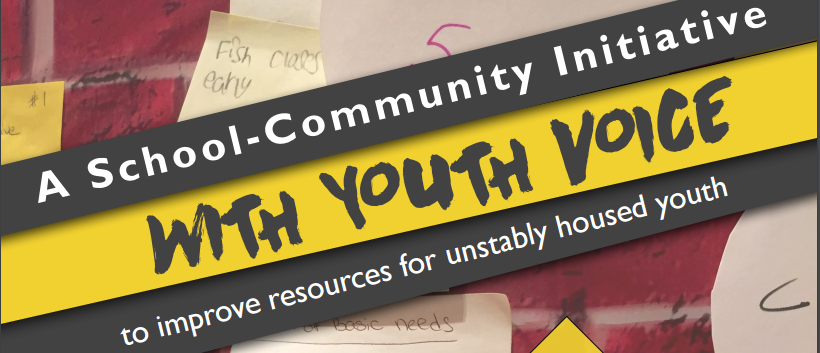Developing Successful School-Community Initiatives to End Youth Homelessness
Community-based initiatives that are driven by youth voice and that establish strong linkages between schools and community organizations have an important role to play in the effort to end youth homelessness. This webpage offers communities tools to help build the collaboration and resources necessary to develop local systems to assist unstably housed youth in their regions. The guidebook and workshop material focus on building youth-adult school-community (YASC) initiatives to improve resources for unstably housed youth. The guidebook and workshop materials focus on best practices for building youth-adult school community initiatives.
Why Do This?
“Lasting change is not possible without community.” Howard Fuller
Youth homelessness is a national problem and one of the most challenging populations of homelessness to engage in resources and services. The impact of housing insecurity on youth is extensive, influencing young people’s lives from physical and mental health to their overall life trajectory. They are one of the most vulnerable populations, as youth homelessness leads to higher rates of substance use, sexually risky behavior, early parenthood, unemployment, incarceration, mental illness, suicide, and poor educational and health outcomes. These risks can have a serious impact on their future, their likelihood of becoming homeless later in life, and their community.
The Process
“It’s not about a collaborative…it’s about collaborating to be effective.”
This section of the guidebook outlines the process of developing a youth-adult school-community (YASC), where to start to plan, how to cultivate the right mix of leadership and partnerships, how to build knowledge and data, utilizing available and building new resources, and making informed actions to build change.
The Plan
“Effective collaboration requires vision, cohesive policy, leadership, infrastructure, & capacity building”
The guidebook walks you through on the key points for planning, from identifying youth and adult key partners to developing work groups and youth voice. There are a variety of useful materials and resources in this section as well as a community example on how this piece of the process happened in Torrington, Connecticut.
Discovery
This section provides examples of participatory research methods that can be used by a YASC initiative to build knowledge, engage stakeholders and inform collective action. Action driven by data and discovery is one of the core components of a successful YASC initiative. Discovery initiatives could include determining the scope of youth homelessness at a local level, identifying and mapping assets in a community, understanding the key barriers of a region, and determining the gaps in meeting the needs of unstably hosed youth.
Build
It is fairly common practice for researchers to interpret data and develop recommendations for communities. Although this approach may seem practical and efficient, it limits opportunities for community engagement, facilitating ownership, and building consensus for collection action. This plan recommends building and maintaining a data-driven YASC initiative in which the research is driven by the community as a whole. This section also discusses the later steps in the process regarding building and maintaining the Momentum once the initiative has begun.
Materials and Resources
A Guidebook: Developing Successful School-Community Initiatives to improve resources for unstably housed youth.
Workshop PowerPoint: Presentation from the Workshop on Developing Successful School-Community Initiatives to End Youth Homelessness
Workshop Handouts: Handouts from the Workshop on Developing Successful School-Community Initiatives to End Youth Homelessness
For more information or for assistance please contact training@cceh.org.
